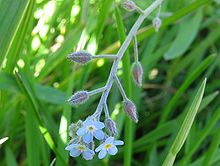Field forget-me-nots
| Field forget-me-nots | ||||||||||||
|---|---|---|---|---|---|---|---|---|---|---|---|---|

Field forget-me-nots ( Myosotis arvensis ) |
||||||||||||
| Systematics | ||||||||||||
|
||||||||||||
| Scientific name | ||||||||||||
| Myosotis arvensis | ||||||||||||
| ( L. ) Hill |
The field forget-me-not ( Myosotis arvensis ) is a species of the forget-me-not genus ( Myosotis ) in the predatory family (Boraginaceae).
description
The field forget-me-not usually grows as an annual plant , it can also grow as an overwintering annual (winter annual) or as a biennial plant . It is herbaceous and reaches heights of 10 to 40 (rarely 60) cm. The stems are ascending to upright and often strongly branched from the bottom. In the leafy area the stems are protruding, in the non-leafed area they are hairy. The hair is not hooked. The basal rosette leaves are up to 8 × 1.5 cm in size. Their shape is inverted-lanceolate, gradually narrowing into the petiole.
The stem leaves are sessile, usually 2 to 5 cm long and covered with straight hair. Their shape is lanceolate to ovate.
The inflorescence is dense, not leafed at the base. The lower flowers also have no bracts . At the time of fruiting, the flower stalk sticks out horizontally and is then two to three times as long as the calyx. The calyx has protruding, hooked hairs and is 7 mm long when the fruit is ripe. The calyx tips then bend together and close the calyx. The crown is blue and 2 to 4 (rarely 5) mm wide. Its hem is deepened like a funnel.
The partial fruits are a maximum of 2.5 × 1.2 mm and have two sharp edges. Their color is greenish-black to black. They have no appendages.
The number of chromosomes is 2n = (36, 48) 52, 54 or 66.
Pollination ecology
Pollination takes place by dipteras , small apoids and butterflies. Spontaneous self-pollination is common. The flowering period extends from April to October.
distribution
The field forget-me-not is native to Europe, West Asia, the Caucasus, Kazakhstan and North Africa as well as the Canary Islands. It has a meridional-montane to boreal, sub-oceanic area. The question of whether it is indigenous in Central Europe or an archaeophyte has not been clarified. In Germany and Austria it occurs everywhere and is common.
It grows in fields, on roadsides, ruderal spots and in bushes. It prefers fresh, nutrient-rich loamy soils and occurs from the collines to the montane elevations , rarely as far as the subalpine . In the plant-sociological system, the field forget-me-not is a character species of the Secalietea class, the Segetal weed communities. But it also occurs in societies of the order Polygono-Chenopodietalia or Atropetalia.
Systematics
Synonyms for Myosotis arvensis (L.) Hill are: Myosotis intermedia Link , Myosotis ludovici Sennen and Myosotis antonii Sennen .
Within the species Myosotis arvensis , two subspecies are distinguished:
- Myosotis arvensis subsp. arvensis , the common field forget-me-not.
- Myosotis arvensis subsp. umbrata (Rouy) O. Schwarz (Syn .: Myosotis pseudosylvatica Schur ), the shadow-loving field forget-me-not. This subspecies occurs in Portugal, Spain, France, Italy, Great Britain, Ireland, Belgium, Germany, the Netherlands, Switzerland, Iceland, Norway, Denmark, Sardinia, Corsica, Romania and on the Faroe Islands.
Medical use
Myosotis arvensis is used in homeopathic medicinal products as an active ingredient, especially against swelling of the lymph nodes. This ascribed effect has not been scientifically confirmed.
supporting documents
- Rudolf Schubert , Klaus Werner, Hermann Meusel (eds.): Excursion flora for the areas of the GDR and the FRG . Founded by Werner Rothmaler. 13th edition. tape 2 : vascular plants . People and knowledge, Berlin 1987, ISBN 3-06-012539-2 (area).
- Siegmund Seybold (Ed.): Schmeil-Fitschen interactive . CD-ROM, version 1.1. Quelle & Meyer, Wiebelsheim 2002, ISBN 3-494-01327-6 .
Individual evidence
- ↑ a b c Erich Oberdorfer : Plant-sociological excursion flora for Germany and neighboring areas . With the collaboration of Angelika Schwabe and Theo Müller. 8th, heavily revised and expanded edition. Eugen Ulmer, Stuttgart (Hohenheim) 2001, ISBN 3-8001-3131-5 , pp. 782 .
- ^ Myosotis in the Germplasm Resources Information Network (GRIN), USDA , ARS , National Genetic Resources Program. National Germplasm Resources Laboratory, Beltsville, Maryland. Retrieved July 19, 2020.
- ↑ a b Benito Valdés, 2011: Boraginaceae. : Data sheet Myosotis arvensis In: Euro + Med Plantbase - the information resource for Euro-Mediterranean plant diversity.
- ↑ Bomble, FW 2012: Critical and little known vascular plant species in the Aachen area I. Jahrb. Bochumer Bot. Ver. 3: 103-114 (PDF 2 MB)
- ↑ Apotheken Umschau: Drug information on Lymphomyosot N drops ( Memento from September 23, 2015 in the Internet Archive )
Web links
- Field forget-me-nots. In: FloraWeb.de.
- Distribution map for Germany. In: Floraweb .
- Myosotis arvensis Hill In: Info Flora , the national data and information center for Swiss flora .
- Distribution in the northern hemisphere from: Eric Hultén, Magnus Fries: Atlas of North European vascular plants. 1986, ISBN 3-87429-263-0 at Den virtuella floran. (swedish).

